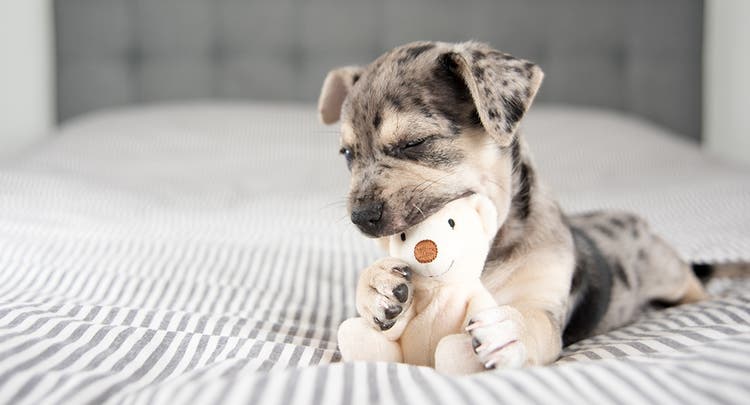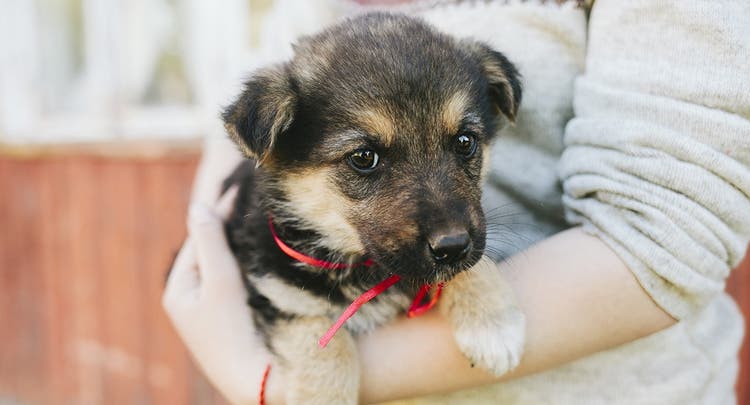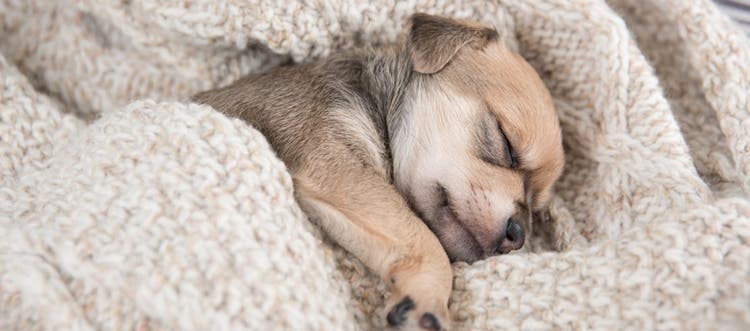How to teach your new puppy not to bite.
Nipping is a natural expression of a puppy’s playful curiosity and a way for them to reduce the pain of teething. However, the sooner you curb this behavior, the better.
Teaching your puppy not to bite is an important part of training because a biting adult dog is a serious danger to others, especially children and pets. Use these five steps to make sure the training sticks.
How to Help Stop Your Puppy from Nipping and Biting
Step 1: No Hard Biting
It can be tempting to try to completely stop your puppy’s biting and mouthing from the beginning. However, doing so will skip a vital step: allowing your puppy to understand the limits of how hard they can press against skin before it becomes painful. Teaching this lesson gives your puppy an instinct against causing harm if they should become stressed or scared.
To teach your puppy not to bite hard, take your cues from natural puppy play. Gentle mouthing and nibbling is natural behavior, so let your puppy indulge in this, but when you feel a hard bite, make a yelping sound and let your hand lie still.
This action will show your puppy they’ve gone too far and they’ll learn to adjust. Everyone who plays with the puppy should adopt this strategy so that eventually your puppy will be gentler. Remember: Consistency is an important part of puppy training and will help reinforce these lessons.
Step 2: No Teeth on Skin
Now that your puppy has learned the pain threshold for biting human skin, it’s time for the next lesson: no teeth on skin. To do this, continue with the previous technique, but slowly reduce the strength of bite that will cause you to yelp and go limp. This will show your puppy that no level of teeth on skin is acceptable.
You can reinforce this training exercise with treats. Hold a treat in a closed hand, and only open your hand when your puppy is not mouthing, chewing or pawing at your fingers. This will demonstrate that mouths and skin do not belong together. It may take some time and patience, but your puppy will learn and adapt.
Step 3: Use Toys to Redirect Their Attention
Early on, puppies need to know that chewing on toys is fine, but chewing on skin is not. While your puppy is learning the first two lessons, make sure to provide plenty of chew toys so they can understand that while skin is a no-no, toys can be chewed to their heart’s content.
Step 4: Walk Away
Puppies and young children have many traits in common: Both can find it hard to focus on learning, particularly when they’re excited. Sometimes, the best thing to do is give your puppy a little time to calm down in their playpen, perhaps with a nice chew toy, if they are having trouble focusing.
Don’t think of this as a punishment — it’s simply a chance for your puppy to calm down. Training can resume when your pup feels a little more relaxed.
Step 5: Discourage Herding Instincts
Some breeds of dog, such as collies or Shetland sheepdogs, have strong herding instincts, which can lead them to nip at ankles in an effort to keep the “herd” moving. If your dog does this, try to stand still so they understand that nipping ankles will have the opposite effect than they intend.
Above All, Stay Calm and Focused
Puppy training requires a lot of patience and dedication. Your puppy may not understand the lessons you’re trying to teach right away, but it’s best to remain calm and focused regardless. Shouting at your puppy or scolding them may frighten them or cause them unnecessary stress, which can lead to the exact behavior you’re trying to prevent.
If you think your puppy is struggling to learn not to bite, consider seeking the help of a professional trainer. Dogs that bite are a danger to you and others — and at the end of the day, it’s your responsibility to ensure your dog is safe to be around.
With a little patience and a lot of consistency in your training, you can help your puppy stop biting and nipping before it becomes an issue.
Related Articles

Puppy Parenting: Our Downloadable Guide
New puppy? Whether this is your first go-round or your fifth, we know that so much goes in to raising healthy, happy pups. Check out our free guide, also available to download!




